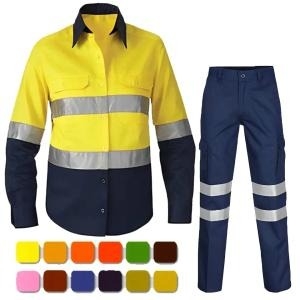Introduction
In today’s diverse work environment, the term "workwear" extends beyond traditional suits and ties. From construction sites to corporate offices, what you wear can significantly impact your performance, comfort, and even brand representation. Modern workwear has evolved to include not just functionality but also personalization and style. Two popular trends that have emerged in this space are embroidery and t-shirt printing. These techniques allow companies and individuals to create unique, branded apparel that stands out. Let's delve into how these elements can enhance your workwear wardrobe.
The Evolution of Workwear
Workwear has undergone a significant transformation over the years. Initially, workwear was all about durability and protection. Think heavy-duty fabrics, steel-toe boots, and hard hats. However, as workplaces have diversified, so have the needs and preferences of employees. Today’s workwear not only needs to be functional but also comfortable and representative of a company’s brand.
The Importance of Comfort and Style
Comfort in workwear cannot be overstated. Employees who are comfortable in their attire are likely to be more productive and happier. Furthermore, style plays a crucial role. In many industries, the way employees dress can impact customer perceptions and even the company’s brand identity. This is where customization techniques like embroidery and t-shirt printing come into play.
The Art of Embroidery in Workwear
Embroidery is an age-old technique that involves decorating fabric with needle and thread. In the context of workwear, it adds a touch of professionalism and durability that is hard to match.
Why Choose Embroidery?
Embroidery is highly valued for its durability and high-quality finish. When a logo or design is embroidered onto a garment, it becomes part of the fabric, ensuring it withstands the test of time. This makes it an excellent choice for workwear that needs to endure frequent washing and tough conditions.
Applications of Embroidery
Embroidery is versatile and can be applied to a wide range of workwear items, including polo shirts, jackets, hats, and even aprons. For instance, a construction company might opt for embroidered logos on high-visibility vests, while a corporate office might prefer embroidered polos for a polished look.
Tips for Effective Embroidery
- Choose the Right Fabric: Embroidery works best on fabrics that are sturdy and have a tight weave. Cotton, polyester, and blends are popular choices.
- Opt for High-Quality Thread: High-quality thread ensures that the embroidery doesn’t fade or fray over time.
- Simple Designs Work Best: While embroidery can handle detailed designs, simple logos and text often look cleaner and more professional.
The Versatility of T-Shirt Printing
T shirt printing is another fantastic way to customize workwear. This method involves transferring a design onto a garment using ink. There are several techniques, including screen printing, digital printing, and heat transfer.
Benefits of T-Shirt Printing
T-shirt printing is highly versatile and cost-effective, especially for large orders. It allows for a wide range of colors and complex designs, making it ideal for vibrant logos and graphics.
Different Printing Techniques
- Screen Printing: Ideal for bulk orders, screen printing offers vibrant colors and durability.
- Digital Printing: Perfect for small batches and complex designs, digital printing provides high detail and a soft finish.
- Heat Transfer: Best for short runs and custom designs, heat transfer is quick and efficient.
Tips for Effective T-Shirt Printing
- Select the Right Printing Method: Choose the printing method that best suits your design and quantity needs.
- High-Quality Images: Ensure your designs are high resolution to avoid pixelation and blurriness.
- Pre-Shrunk Garments: Use pre-shrunk t-shirts to ensure the print remains intact after washing.
Combining Embroidery and T-Shirt Printing
For a truly unique and professional look, many companies opt to combine both embroidery and t-shirt printing in their workwear. For example, you might have an embroidered logo on the chest and a printed graphic on the back of a polo shirt. This approach allows you to take advantage of the durability of embroidery and the versatility of t-shirt printing.
Conclusion
In the modern workplace, workwear is more than just clothing—it’s a statement of professionalism, comfort, and brand identity. By incorporating embroidery and t-shirt printing, companies can create custom workwear that meets their specific needs and stands out in a crowd. Whether you’re looking to outfit a construction crew or a corporate team, these techniques offer endless possibilities for customization and personalization. So, the next time you’re considering workwear options, remember the powerful impact of well-chosen embroidery and t-shirt printing.



